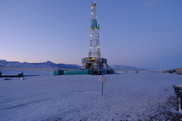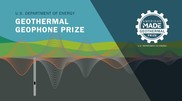|
DOE Invests $6 Million in Geothermal Heating and Cooling Technologies at Federal Facilities
GTO selected ORNL to receive up to $6 million to help expand the deployment of geothermal heating and cooling technology at federal sites. The federal government is the nation’s largest energy user, consuming nearly 1% of all end-use energy in the United States. Installing these carbon-free heating and cooling systems at federal sites will support President Biden’s goal to make the federal government carbon-neutral and help demonstrate the benefits and potential of this technology.
Announcing Inclusive Energy Innovation Prize Winners

Please join GTO in congratulating the Phase One winners for DOE’s Inclusive Energy Innovation Prize. The winners will receive $200,000 to carry out bottom-up solutions for sustainable development in communities historically underserved in federal climate and energy technology funding. The prize enables and enhances business and technology incubation, acceleration, and other community-based and university-based entrepreneurship and innovation in climate and clean energy technologies. Phase Two, which is only open to Phase One awardees, has kicked off and will conclude in spring 2023. Interested in learning about other prizes? Visit the American-Made Challenges website.
|
$10 Million Available to Develop Tools to Assess Place-Based Energy Generation
DOE announced a new $10 million funding opportunity, Energyshed: Exploring Place‐Based Generation, to develop tools and processes to assess the impacts of electricity generated and used within a local geographic area. These tools will empower stakeholders to make informed decisions about using locally generated electricity. They will also support more reliable, resilient, efficient, and affordable grids that can address inequities in the distribution of cost and benefits across energy systems. Projects will incorporate local data relevant to the environmental, economic, and equity attributes of each power system and will develop tools that are easy to use for a wide array of non-technical audiences. Learn more and attend an informational webinar on June 22 at 2 p.m. ET.
DOE To Support Clean Energy Transition in 12 Remote and Island Communities

Last week, DOE announced it will partner with 12 competitively selected remote and island communities to transform their energy systems and increase energy resilience. Through its Energy Transitions Initiative Partnership Project (ETIPP), DOE and its partners will support projects that help lower energy costs and stabilize vulnerable energy infrastructure. These communities are particularly at-risk to wide swings in energy costs and prolonged outages, as natural disasters become more commonplace due to climate change. Read about the selected communities, and watch this video to learn more about ETIPP.
|
Learn More about Utah FORGE Solicitation 2020-1 Awardees

This past winter, the Frontier Observatory for Research in Geothermal Energy (FORGE) initiative kicked off 17 research and development projects following Solicitation 2020-1, which was released in April 2020. This portfolio covers testing and evaluation of new and innovative enhanced geothermal systems (EGS) tools and techniques across five topic areas, with a combined total funding of $46 million to be spent over the next three years. Read more about the projects’ objectives.
|
FORGE-ing Ahead With U.S. Geothermal
In April, the Utah FORGE team successfully completed a three-stage hydraulic stimulation of its first highly deviated injection well, an important phase of the project and a key milestone in creating a fully human-made geothermal reservoir. Initial results are promising, and after the new subsurface reservoir is mapped, the FORGE team anticipates drilling the second full-size wellbore in early 2023. With continued success, FORGE has the potential to chart a commercial pathway for further EGS development. Read the full EERE Success Story and watch the process.
Celebrating 10 years of the Geothermal Data Repository (GDR)

This July, get involved with GTO’s month-long celebration of GDR! Explore GDR, the publicly available resource for geothermal stakeholders, to find data on new reports and projects funded by the GTO and to honor the decade it has served the geothermal community. Students are helping us celebrate by forming teams for the Society of Petroleum Engineers’ Student Datathon event, which will start on June 21. Participants will be challenged to solve a geothermal engineering problem using real field data from FORGE. Watch out for more info about the GDR birthday celebration!
|
Geothermal Geophone Prize: Sign Up for Office Hours!

In April, GTO launched the Geothermal Geophone Prize. This provides $3.65 million in total incentives and engages with the nation’s innovators and entrepreneurs to fast-track innovation in seismic sensors that support EGS. Downhole seismic sensors, also known as geophones, help researchers and industry professionals better understand and track changes in the subsurface during EGS stimulation. If you are interested in participating in the challenge, sign-up for office hours with the Clean Energy Business Network to ask questions and learn more about resources. The Phase 1 submission deadline is Sept. 29, 2022.
|
Bipartisan Infrastructure Law: 180-Day Progress Update
On May 23, DOE hosted a webinar with Energy Secretary Jennifer Granholm and Principal Deputy Under Secretary for Infrastructure Kathleen Hogan to provide updates on the implementation of the Bipartisan Infrastructure Law (BIL) and to share progress from the first 180 days. The webinar offered an overview of updates on the $10 billion BIL funding that has already been released, as well as a preview of upcoming funding opportunities. In addition, the event highlights how equity and the Justice40 initiative are being incorporated into BIL programs, and includes an engaging Q&A. Watch it now and sign up for BIL updates.
GTO Quarterly Webinar Recap
If you missed GTO’s virtual quarterly webinar on June 9, view the slides and a transcript to learn more about DOE and GTO news, funding opportunities, and project updates. Questions about the webinar? Email DOE.Geothermal@ee.doe.gov.
Bill Nye Visits the Cornell University Borehole Observatory
Bill Nye, a '77 graduate, was on-site at the Cornell University Borehole Observatory (CUBO) on June 10. Watch as he explains how Cornell can move forward with Earth Source Heat, a novel geothermal energy system. With the support of GTO, Cornell is drilling an exploratory borehole to measure, test, and verify that Earth Source Heat can heat the campus and demonstrate the scalability of this technology to other facilities.
Mining and Geothermal Industries Could Strike G.O.L.D. Through Partnership. By teaming up, the mining and geothermal industry could positively impact the race to a renewable future. Mining data can reveal hidden geothermal resources, saving time, money, and resources for the geothermal industry.
Inside the Deepest Underground Lab in the US. Tour the Sanford Underground Research Facility, which is conducting one of the biggest geothermal research projects focused on EGS. Fast forward to minute 11 to learn the intricacies of GTO-funded EGS Collab.
Ormat Signs PPAs with NV Energy for up to 160 MW of Geothermal Power. In addition to the 26-MW Geothermal power purchase agreement (PPA) announced with Peninsula Clean Energy in April, Ormat just announced two additional PPAs totaling 160 MW of geothermal energy with NV Energy.
What Are Geophones? Sensors that collect sounds from the earth. These seismic monitoring tools are especially helpful to collect information during an EGS stimulation to ensure safety. GTO funds the American-Made Geothermal Geophone Prize to spark innovation and address the challenges of operating seismic sensors in geothermal environments.
Tri-Cities Researchers Say They Can Extract Lithium From Water. That’s a big deal. Because lithium is in high demand, researchers are exploring the possibility of using magnets to extract the element from water, including briny groundwater used by geothermal power plants. Iron-based nanoparticles technology could be essential for the future extraction of lithium.
Geothermal System Is a Real Goldmine. Stemming from GTO-funded research, a Pacific Northwest National Laboratories EGS project could potentially power 10 million homes using an old gold mine and geothermal energy—a perfect pair.
Enhanced Geothermal System Uses Oil and Gas Technology to Mine Low-carbon Energy. Part 1. John McLennan, principal investigator of FORGE, answers questions about the history of geothermal energy, the EGS process, and the trajectory of Utah FORGE. Read Part 2 of the Forbes article for more.
Cook Inlet basin energy future lies beyond fossil fuels, conference speakers say. The tables are turning for the Kenai Peninsula, once known as the oil capital of Alaska. The area offers the potential to produce renewable energy due to old oil and gas wells, which can be useful for geothermal energy production.
Answer: The Geysers Geothermal Complex is just north of San Francisco, California.
Did we miss your event or an interesting media piece? Please reach out to us at DOE.Geothermal@ee.doe.gov!
|